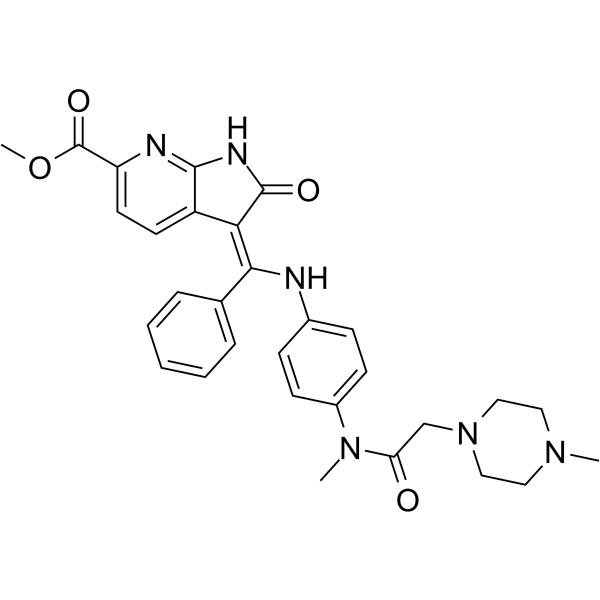| Description |
Ansornitinib is an orally active dual kinase inhibitor that inhibits platelet-derived growth factor receptor (PDGFR) and vascular endothelial growth factor receptor (VEGFR2). Ansornitinib can be used as an antifibrotic agent in lung, liver, kidney, and gastrointestinal fibrotic diseases[1].
|
| Related Catalog |
|
| In Vitro |
Ansornitinib (compound I) (0.1 nM-10 μM, 2 h) can significantly inhibit the phosphorylation of PDGFRβ in human hepatic stellate cells and KDR phosphorylation in human umbilical vein endothelial cells (HUVEC)[1]. Ansornitinib (compound I) (0.1-13 μM, 48 h) can induce a decrease in the expression of many different inflammation-related markers, such as macrophage colony-stimulating factor (M-CSF), soluble interleukin 8, and fibrosis-related markers, such as N-calmodulin, α-SMA, etc., in a dose-dependent manner[1].
|
| In Vivo |
Ansornitinib (compound I) (25 mg/kg, p.o., twice a day, 4 weeks) can reduce fibrosis in TGFβ positive female mice[1]. Ansornitinib (compound I) (5-45 mg/kg, p.o., twice a day, 4 days) can reduce inflammatory bowel disease (IBD) in TNBS-induced IBD/acute colitis male CD-1 mice[1]. Animal Model: 8-10 weeks TGFβ positive female mice[1] Dosage: 25 mg/kg Administration: Oral administration; twice a day; 4 weeks Result: Reduced lung fibrosis score, lung hydroxyproline levels and αSMA, a marker of early pulmonary fibrosis. Animal Model: TNBS-induced IBD/acute colitis male CD-1 mice[1] Dosage: 5, 15, 45 mg/kg Administration: Oral administration; twice a day; 4 days Result: Improved colonic histology and reduced the TNBS-induced loss of cupped cells at 15 mg/kg and 45 mg/kg significantly. Reduced the expression level of myeloperoxidase (MPO) at 5 mg/kg and 15 mg/kg significantly while there was no statistical difference at 45 mg/kg. Animal Model: Male Sprague Dawley rats[1] Dosage: 30 mg/kg Administration: Intravenous injection; once Result: The pharmacokinetic parameters of Ansornitinib (compound I) Parameter Ansornitinib (compound I) t1/2 4.1 h Tmax 0.518 h Cmax 7860 ng/mL Clearance 173 mL/kg/min steady-state volume 18.2 L/kg AUC0-last 3180 ng/mL*h AUC0‑inf_obs 3200 ng/mL*h
|
| References |
[1]. Shakil ASLAM, et al. Reducing fibrosis and treating related diseases, disorders, and conditions. WO2022006278
|
